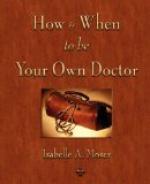Her husband was then instructed in her maintenance and they went home to continue the program. The last I heard from them they had made two lengthy trips around the US in their RV and were enjoying their retirement together after all.
My treatment worked because the most important factor in the healing of the critically ill person is not give them more nourishment than their body is able to process. The moment the digestive capacity of the sick person is exceeded, the condition will be exacerbated and in a critically illness, the person is likely to die. If the body still has sufficient organ integrity and vital force to heal itself, it will do so only if given the least possible nourishment that will support life—provided no essential organs are hopelessly damaged. If the liver and kidneys are functional, and the person has done some previous dietary improvement and/or cleansing, success is likely, especially if the person wants to live.
A person in critical condition does not have time to ease into fasting by first spending a month or two on a raw foods diet. This means that the person who is taking care of the critically ill person must be experienced enough to adjust the intensity of the body’s healing efforts and accurately assess the ability of the person to process toxic waste products clamoring for removal so the ailing body is not drowned in it’s own poisons. It is often necessary to use clear vegetable broth, vegetable and wheat grass juices, and fruits juices, or whole sprouts to slow down the cleansing gradient and sometimes, to resupply the tissue’s exhausted nutritional reserves.
I wish all cases of critical illness had such a positive outcome as Ethyl’s, but unfortunately they don’t. I had Marge on the same program at the same time. She also had cancerous tumors all over her body and had similarly been sent home to die. In some ways Marge’s body was a more likely candidate for survival than Ethyl’s. Marge did not have heart failure or diabetes and was still able on arrival to at least take small amount of water orally and walk to the bathroom. Put on a similar program, her tumors also shrunk and were reabsorbed and she too went home.
But Marge did not really have a strong reason to live. Although her husband was by her side throughout the treatment program, Marge was deeply upset because she was estranged from one of her sons who she had not seen for over 10 years. When she went home from Great Oaks, the son finally consented to see his mother, went to the effort of trying to work things out with her, and finally confessed that under it all he still loved her.
At that point Marge died in peace. She had accomplished the last thing she wanted to take care of and her will to live did not extend beyond that point. Had she died several months earlier as predicted by the medical profession, Marge would have been unable to resolve this relationship. This was what Marge’s life was pivoting on at the end. I was glad to assist her in doing what she needed to do. Her husband and other family members found it difficult to understand, and they were hurt that Marge did not wish to continue her life with them.




